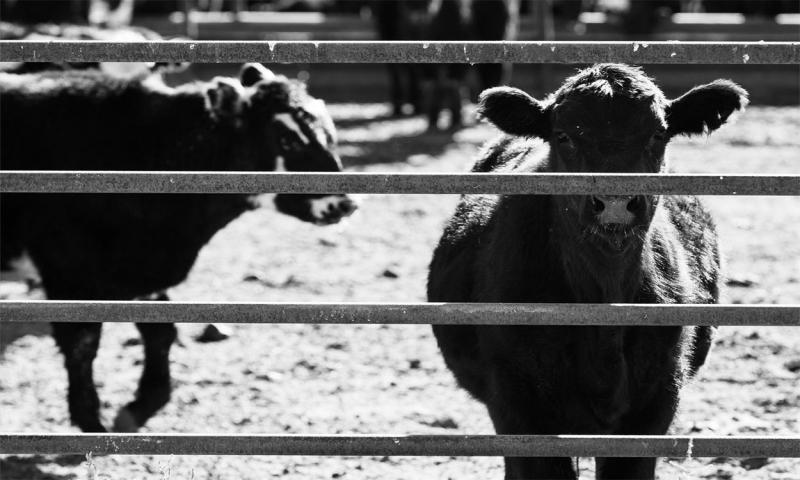
Written by Kiernan Brandt, former SDSU Extension Cow/Calf Field Specialist, and Olivia Amundson, former SDSU Extension Cow/Calf Field Specialist.
As drought conditions continue in much of the Midwest, the amount of cows going to the sale barn continues to be exceptionally high. Cows may be heading to the sale barn without calves, with calves at side, pregnant or previously exposed to a herd bull. The opportunity to buy cows cheap, add value and sell high becomes an opportunity for buyers in the market. The question becomes, what can be done with these cows if bought from the sale barn?
Traditionally, cows bought as culls or determined culls by producers find their way into a drylot or crop residue situations to put on additional gain. The additional pounds, along with selling in a better market, provides the opportunity for that female to provide additional revenue, which she otherwise would have missed out on. For more information on feeding cull cows, refer to the article, Considerations for Cull Cows.
With increasing amounts of cows being sold at the sale barn with reproductive years left, there are some precautions to be aware of prior to bringing that female home to re-breed.
South Dakota Animal Industry Board
According to the South Dakota Animal Industry Board (SD AIB) there are regulations when it comes to bringing a cull cow home from the sale barn.
Trichomoniasis (trich) is a sexually transmitted disease in cows and bulls that results in reproductive inefficiencies. This includes early embryonic death or abortions up to day 240 of gestation in a pregnant cow. Trich can also impact subsequent cycling of the females in the herd. Unfortunately, trich can initially be attributed to other factors causing the disease to go undetected and quickly spread. It isn’t until the disease has become well established in the herd that producers become aware of the situation. In open herds, or herds where cows are bought and comingled with other animals, trich can become an issue that can be financially devastating. Losses in calf crop from 10–30% have been reported when introducing infected animals, growing to over 50% in subsequent years if left untreated.
The South Dakota State Veterinarian, Dustin Oedekoven, states that in the early 2000s, the beef cattle industry in South Dakota saw a spike of reproductive inefficiency. In 2004, 45 western South Dakota beef herds were diagnosed with trich. In 2008, during a drought year, some of the regulations were mitigated for cattle being sold due to shortage of forage availability. Unfortunately, the following year, the number of trich cases were up. Therefore, the SD AIB has put into place rules to help prevent the spread of trich in cattle. Specifically, rules to help prevent the spread of this costly disease.
Rules and Regulations
Initially, the board started regulating the sale of bulls and bulls imported into the state. These rules are similar to those of neighboring states who address the risk of bulls carrying the disease:
- Require non-virgin breeding bulls to be tested prior to import into South Dakota, or prior to sale within the state.
The SD AIB went one step further and considered the sale of cull cows within the state that were potentially carrying the disease and, in turn, introducing it into herds. Since diagnostic testing for trich in females is limited beyond a female with an active infection, any female who fails to carry a pregnancy beyond four months is suspect for infection. In most cases, cows will clear the disease, however this requires time, and during the three-to-five heats before finally rebreeding, every bull that breeds her will be exposed to the disease. Bulls that contact trich cannot be treated and must be sold for slaughter. Therefore, rules for the sale of cows in South Dakota are as implied:
- No non-virgin and non-pregnant female cattle may be imported, loaned, leased, nor acquired for breeding purposes in South Dakota.
- However, non-virgin and non-pregnant female cattle registered with a breed registry, or to be used in confined dairy operations, may be exempt from the provisions of this section as determined by the board.
- Non-virgin and non-pregnant female cattle, each accompanied by its own offspring and prior to rebreeding, are exempt from the provisions of this section.
- Non-virgin, non-pregnant female cattle used in embryo-transplant operations may be exempted from this section based upon a risk assessment by the board.
While these rules can be difficult to regulate, the impact of decreasing the incidence of trich and other reproductive diseases in South Dakota herds is the ultimate goal. Trich tests in the cow require five consecutive negative tests a week apart, so the best preventative measure is to ensure all bulls entering the battery have an up-to-date negative test and are re-tested at the conclusion of the breeding season, with any positives being culled. So, when considering options for cull cows, understand the potential consequence associated with bringing cows into the breeding herd. For questions or more information on this topic contact a South Dakota State University Cow/Calf Field Specialist.


